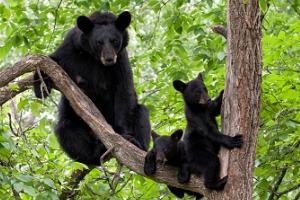New microbes found in an abandoned mine, a bat cave and black bears
Posted on August 11, 2020 by Laura Cox
Each month, the Microbiology Society publishes the International Journal of Systematic and Evolutionary Microbiology (IJSEM), which details newly discovered species of bacteria, fungi and protists. Here are some of the new species that have been discovered and the places they’ve been found.
Deep underground in an abandoned mine, two new species of bacteria were discovered by researchers in China this month. Hymenobacter fodinae and Hymenobacter metallicola were found down a shaft that was previously used to mine lead and zinc. These new species both form red-to-pinkish colonies when cultured in the lab and were found in samples of lead-zinc ore.
In Japan, six new species of yeast were discovered in bat-inhabited caves. Samples were collected from bat droppings in the caves and four new species of Aiotrichum and two new species of Cutaneotrichosporon.
A research team in Germany investigating the microbial communities in unpasteurised milk discovered a new genus of bacteria this month. They found a round, never before seen bacterium in a bulk tank on a dairy farm, which they named Fundicoccus ignavus. Meanwhile, on a fish farm in the Uwa Sea in Japan, another round bacterium was discovered this month. Roseobacter cerasinus was isolated from seawater near the farm. This was not the only micro-organism discovered in the sea this month. Paraglaciecola marina, a yellow, rod-shaped bacterium, was isolated from marine algae and grows best at cooler temperatures.

An international research team based in Switzerland and in the USA discovered a new species of bacteria in wild black bears. This new microbe was named Staphylococcus ursi and was found in healthy black bears in the Great Smoky Mountains National Park in Tennessee.
Two microbes in the genus Hymenobacter were found at opposite ends of the Earth this month; Hymenobacter artigasi, a red, rod-shaped bacterium was found in an air sample collected on King George Island, Antarctica. Meanwhile, at the top of the world, a research team from Korea found Hymenobacter polaris in a soil sample taken from an Arctic station.
Insects were another source of new microbes this month. Intestinirhabdus alba – a never-before-seen genus and species – was found in a beetle larva. This new bacterium was collected from the gut of Coleoptera larvae, which eat polystyrene foam as part of their diet, meaning their gut bacteria could be used to degrade plastic pollution in the future. Elsewhere, researchers in India discovered a new species of yeast which they named Suhomyces drosophilae. This new yeast was collected from Drosophila flies which had been feeding on stinkhorn mushrooms.
In a commercial hazelnut orchard in Turkey, researchers investigating the microbial communities in the surrounding soil discovered a new species of actinobacteria. Streptomyces coryli forms brown, branched colonies when cultured in the lab. Elsewhere, in China, the microbial communities of the soil in another forest discovered a new, yellow-coloured microbe, which they named Chitinophaga solisilvae.
S. drosophilae is not the only new species of yeast reported in IJSEM this month. A research team investigating the micro-organisms found in cold environments collected a number of soil samples from glaciers in the Alps and Apennines. During their research, they found Mrakia stelviica and Mrakia montana for the first time.


